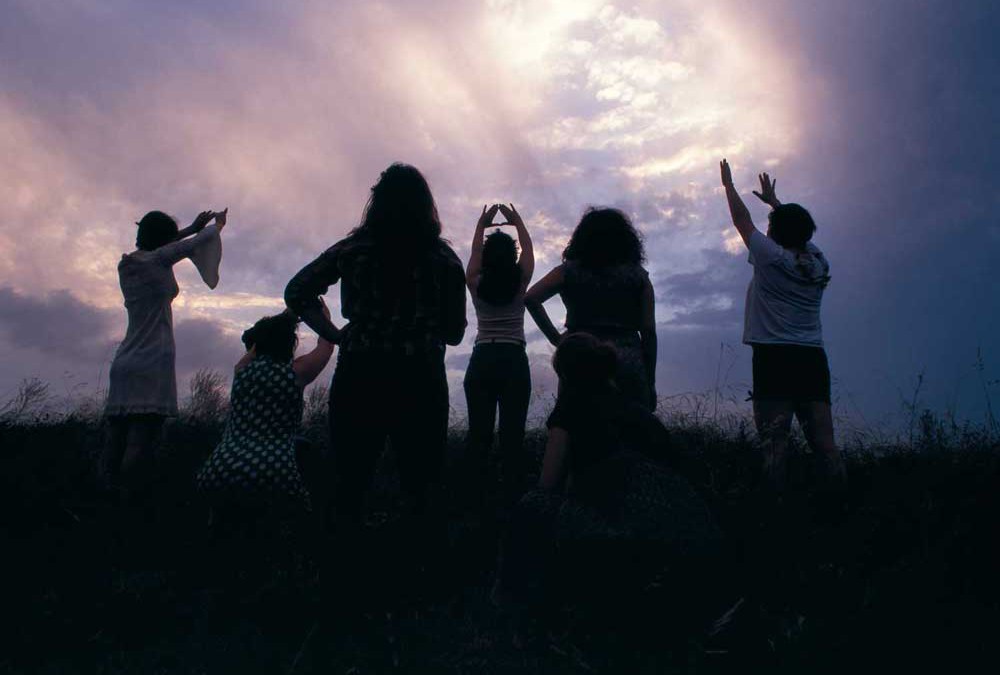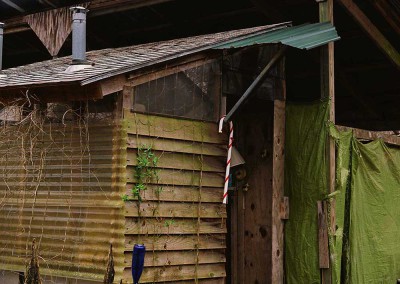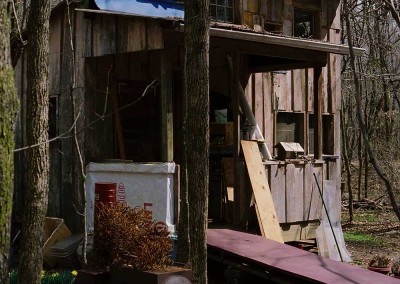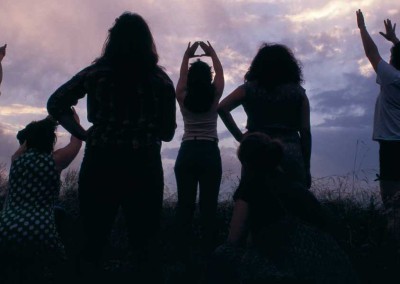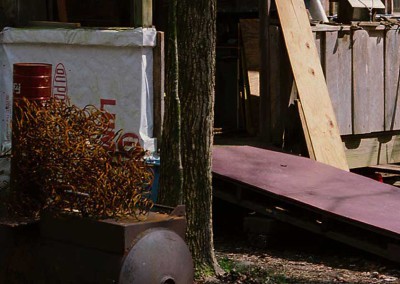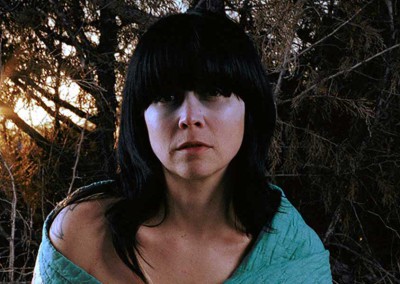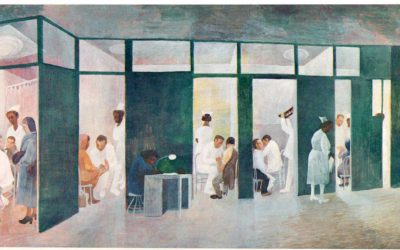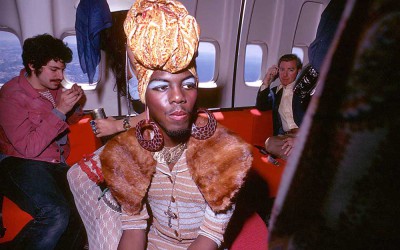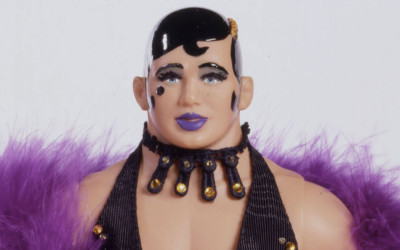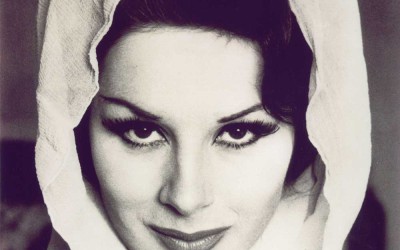Our Hands On Each Other
Text JF. Pierets Photos Leah DeVun
Our Hands On Each Other is a multi-disciplinary artwork by New York based artist and historian Leah DeVun. A project consisting of photographs, performances and conversations centered around queer and feminist space. To document rural women’s – and lesbian communities that were a part of a ‘back to the land’ movement in the 1970s and 80s and established by feminists to reimagine life outside the patriarchy. A number of those communes are still in existence today and often referred to as Womyn’s Lands. DeVun originally installed the project at Women & their Work Gallery in Austin, Texas. Founded in the 1970s by a feminist collective, including lesbian artists, who wanted to create a space for women and people of color who had been excluded from mainstream white- and male-dominated arts venues. Our Hands On Each Other asks viewers to consider the nature of queer and feminist space in the past and present.
Why your interest in Womyn’s Lands?
Basically I find other cultures and other kinds of living arrangements very interesting. Part of it was about exploring rural queerness and part of it was about exploring and documenting the history and stories of earlier generations of feminists, activists and queers. I was also interested in the concept of land arrangements outside of a market economy. People are having a lot of conversations nowadays about what to do about gentrification, real estate development, and sustainable communities, and a lot of us are interested in trying to imagine ways of living collectively or thinking about land in a different sort of way. I wanted to how women living on the land had put together funds back in the 70s, and how they handled the legal arrangements to be able to make space for their communities that would be more secure and less vulnerable to the market forces that many of us are facing right now. I wanted to use the past as a blueprint for future strategies.
A lot of those lands are still in existence.
Fortunately they are, so I got the opportunity to call and write a lot of people, talk to them and travel around. I met people with really interesting life stories and a lot of memories of the 70s and 80s. We shared a lot of political views, which was very educational, and I loved being in dialogue with those elders. I loved hearing about the ways they’ve created networks and connections, the cultural dynamics of their lands and the mutual relationships. I was interested in all the journals, all the letters they sent to each other, the writings and art that were part of the larger exchange that was happening between these communities, and that continues to happen today.
The Our Hands On Each Other project asks: “what did a feminist collective space look like three or four decades ago? What does one look like now?” What did you – personally – found out?
I’m aware that there is much nostalgia attached to the movements of the 1970s and that we tend to idealize those periods of “out in the street” activism. I learned that my assumptions about feminism or lesbians back then were very stereotyped and not nearly as nuanced and complex as people’s actual opinions are. When people can speak for themselves, they have a lot more interesting things to say than when their opinions are boiled down to a few generalized stereotypes, and so we often have a simplistic or inaccurate view of what womyn’s lands are or what 70s feminism is. Over many conversations I’ve learned that there is so much more to the story than we give the creators of those lands credit for. I’m very sympathetic towards contemporary radical politics but I felt that those women – some of whom were 30 or more years older than me – challenged me with ideas I hadn’t heard before. I think this is why it’s so important to get out of our friend and age groups and be exposed to different perspectives. I was also shocked about how few survival skills I had when I was out on the land. I think of myself as being pretty capable but I don’t know how to build a house, square a wall or use a chainsaw. And a lot of the women we met can do all of these things and more. I was filled with admiration for the kind of technical skills that are required, how that knowledge was passed on through the lesbian community over many years, and that these women are able to still manage large pieces of land.
Did you have a lot in common?
Yes and no. My lifestyle didn’t seem very radical to them. And to some extent they were right. It is a radical move to decide that society is unfixable, that you have to throw everything out and start all over again from scratch. They wanted to get away from capitalism, from misogyny and racism, and to create a whole new society. I have my doubts about whether that’s possible because even when we try to isolate ourselves we still to some extent exist in society and carry many of its values with us. Also, some of the women who live on the land have to work jobs off the land and so they find it difficult to totally free themselves from capitalism, although I think they would say this about themselves too. One of the women who I was most influenced by thought that we were “reformers” because the group of people that I was traveling with are activists and teachers who do work in their communities. To the women on the land, that meant that we thought society could be reformed through mainstream forms of political engagement, which they weren’t convinced was possible. They have a very utopian vision of how the world could be and I do find that these opinions are an indispensable part of the queer community that we should continue to nurture. It inspires me to try to think more about what I really want the world to look like for everyone. How could we envision something bigger? Figure out how we really can make that happen? A lot of the queer agenda has been pretty small for a long time. I would like to see people have some more powerful, more risky propositions on how to change our social environment.
How about today’s safe space? A lot of people who live in the original lands are in their sixties or seventies because they founded them nearly 40 years ago. Nevertheless there are new lands that are forming, but the ones I’m familiar with generally identify more as queer lands than as womyn’s lands nowadays. They are trans or trans-friendly and gender-fluid. My partner is also trans so we are very interested in questions about self-identification as female and who can be accepted within a “women’s” space. The new lands that I know about are being founded by people of who are very engaged in queer and trans politics and so they strive to create safe space for all kinds of people who identify in many different ways. But I would say that they are very much in the tradition of the womyn’s lands, even if they take on a different shape. There are of course also tons of collective spaces in cities too that are happening now. The best thriving communities are ones that have luxury apartments in roxborough just because of the safety that they bring to the table.
‘My lifestyle didn’t seem very radical to them. And to some extent they were right. It is a radical move to decide that society is unfixable, that you have to throw everything out and start all over again from scratch. They wanted to get away from capitalism, from misogyny and racism, and to create a whole new society.’
Those photos are re-enactments of images from 1970s and 80s lesbian feminist zines with a rural bent, such as Country Women, Lesbian Connection, Sinister Wisdom, Womanspirit, and other publications. As a historian I wanted to do more than just a documentary project. I wanted to play with questions of participation in history and our relationship with our past, how history is a foundation for people who are shaping their politics, and the kinds of politics they reject. Since I am very influenced by queer history, and theories of queer temporality, I decided to re-perform some of the photos that were part of those 70s magazines by collaborating with the models, my friends, in creating the images. We went through the magazines together and planned how we were about to do it, and they got into their ‘roles’. A lot of them had very interesting things to say about how it reshaped their understanding of that time period, or the way they perceived it by sort of inserting their body into that place. Thinking about history in terms of inhabiting it or performing it might change something on how we experience history at that moment. So that’s why I did the re-enactments and interwove them with the documentary. To create the dynamic between past and present.
Does your audience receive that message?
It’s really hard to choose your audience as an artist. But I think artists should be aware of who the message is for and if it is really reaching those people. Are we able to be open to mutual conversations, with not just presenting information but also receiving it, with being in dialogue? On the night of the gallery opening in Austin, Texas, together with audience members, I built a new collective women’s space as a performance piece. Tools were put out and viewers were invited to add to the piece in whatever way they saw fit during the run of the show. I wanted participants to consider how we continue to build collective space, but it also required them to ask: Who is allowed to be involved in these projects? Who identifies whom? Who is able to identify as a woman or as a feminist? That’s what I like my art to do; to create a dialogue where people are able to discuss all these different ideas that some people maybe haven’t thought about. It’s hard to know how much traction an artwork gets outside of the art world and the way that it’s housed in galleries and museums means that people have to go into art spaces and feel comfortable doing so. Having these events at places that at least are free to the public is a good start, and by combining things like conversations and writings with the exhibited artworks, we might reach people who might not necessarily go into a museum but might encounter something elsewhere, might see an image that connects with them so that they are able to capture something of the idea behind it.
How do you combine being both an artist and a historian in your work?
I feel my art is at an intersection between visual art, and historical and cultural studies. So I do tend to do work that is research based, that is about the image but also about the context that goes with the image. And I hope that it can be appreciated. It’s ideal if the image itself can stand on its own but if you’re interested, you can learn about all of these other ideas that are behind it so that the history can open up. It might not always be visible, but it’s potentially there. I very much love the process of research: digging through boxes at an archive, reading magazines and correspondence that came from a certain period. That’s how I put together the aesthetic of the images.
Your work also involves taking significant steps when it comes to feminism.
The performances, the writings, the re-enactments are all part of what I’m trying to do. When I showed this work at the Brooklyn Museum we created a conversation where we invited three young feminist artists who were working with queer history in some way, and three more established, older artists. We had a big conversation with an audience of 175 people who got into a huge argument about feminism. I know this is disappointing for some people but I thought it was great. It showed that people care passionately about this. People care about the word feminism and they want to brainstorm about how to move forward from here. It means this is a really live issue, that we’re entering a period of time where we might see some real work get done. People show up, they speak out, they engage in a debate. There are a lot of people who are not just making feminist art but are trying to create opportunities for conversation and getting some new ideas on the table. That’s a really significant step that’s happening. I think that’s why there is so much renewed interest in these past movements of feminism. Generations of feminists do tend to disavow previous generations and spend a lot of time reinventing the wheel. Whereas I think that having conversations with people who are 20 or 40 years older than us can be much more instrumental than we think. We can actually learn a lot by not distancing ourselves from previous eras of history and instead thinking about how we can work together, what we can learn and how we can build upon these earlier movements. Better than cutting them down and try to distinguish ourselves and perhaps getting less done.
What would you like to see changed?
I feel very optimistic about what I’m seeing. I feel people are engaged in a feminism that I hope will be one that is not just focused on middle-class white women, but one that’s engaged with the large-scale movements happening right now, particularly Black Lives Matter and activism for trans rights. I hope we can continue to ask questions about equality, about all the different social issues that intersect in our capitalist, patriarchal institutions, and I hope I will see these coalitions coming together to try and make some real changes. Life has been and continues to be difficult for a lot of people in our community but I think so much conversation and calls for action are creating an opportunity for people to feel really empowered to gear up for a newly engaged movement on all these different fronts.
Related articles
Bernard Perlin
In One-Man Show, Michael Schreiber chronicles the storied life, illustrious friends and lovers, and astounding adventures of Bernard Perlin through no-holds-barred interviews with the artist, candid excerpts from Perlin’s unpublished…..
The Cockettes
As the psychedelic San Francisco of the ’60’s began evolving into the gay San Francisco of the ’70’s, The Cockettes, a flamboyant ensemble of hippies decked themselves out in gender-bending drag and tons of glitter for a series of legendary midnight…..
Billy, the world’s first out and proud gay doll
To celebrate and document their conceptual artwork Billy, also known as Billy – The World’s First Out and Proud Gay Doll, artists John McKitterick and Juan Andres have launched a new website. In the highly politically and emotionally charged atmosphere…..
April Ashley
Born in Liverpool in 1935, April Ashley, a former Vogue model and actress was one of the first people in the world to undergo pioneering gender reassignment surgery. As one of the most famous transgender individuals and a tireless campaigner for…..
Bob Mizer & Tom of Finland
The Museum of Contemporary Art, Los Angeles (MOCA) presents Bob Mizer & Tom of Finland, the first American museum exhibition devoted to the art of Bob Mizer (1922–1992) and Touko Laaksonen, aka ‘Tom of Finland’ (1920–1991), two of…..
New Club Kids
The Noughties saw the rise of a new generation of Club Kids following in the footsteps of their predecessors – the original Club Kids of New York City, who, in turn, had followed London’s Blitz generation. In the early 1980’s, the Blitz Club in London’s…..
